
Honoré de Balzac was a French novelist and playwright. The novel sequence La Comédie humaine, which presents a panorama of post-Napoleonic French life, is generally viewed as his magnum opus.
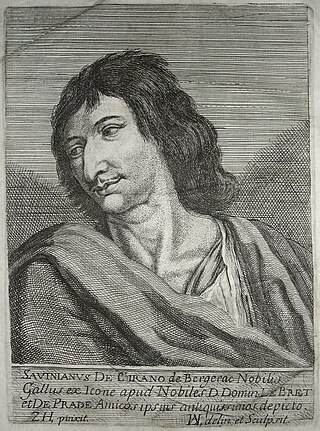
Savinien de Cyrano de Bergerac was a French novelist, playwright, epistolarian, and duelist.

Gérard de Nerval was the pen name of the French writer, poet, and translator Gérard Labrunie, a major figure of French romanticism, best known for his novellas and poems, especially the collection Les Filles du feu, which included the novella Sylvie and the poem "El Desdichado". Through his translations, Nerval played a major role in introducing French readers to the works of German Romantic authors, including Klopstock, Schiller, Bürger and Goethe. His later work merged poetry and journalism in a fictional context and influenced Marcel Proust. His last novella, Aurélia ou le rêve et la vie, influenced André Breton and Surrealism.

La Tour d'Argent is a historic restaurant in the 5th arrondissement of Paris, France. It is located at 15 Quai de la Tournelle. It has a rating of one star from the Guide Michelin.

La Comédie humaine is Honoré de Balzac's 1829–48 multi-volume collection of interlinked novels and stories depicting French society in the period of the Restoration (1815–30) and the July Monarchy (1830–48).

Illusions perdues — in English, Lost Illusions — is a serial novel written by the French writer Honoré de Balzac between 1837 and 1843. It consists of three parts, starting in provincial France, thereafter moving to Paris, and finally returning to the provinces. The book resembles another of Balzac's greatest novels, La Rabouilleuse, that is set in Paris and in the provinces. It forms part of the Scènes de la vie de province in La Comédie humaine.
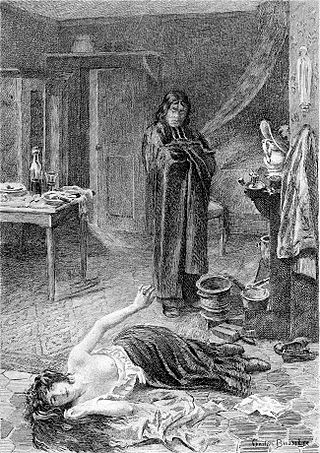
Splendeurs et misères des courtisanes, translated variously as The Splendors and Miseries of Courtesans, A Harlot High and Low, or as Lost Souls, is an 1838–1847 novel by French novelist Honoré de Balzac, published in four initially separate parts:
François Taillandier is a French writer portraying the French contemporary society.

Louis Candide Boulanger was a French Romantic painter, pastellist, lithographer and a poet, known for his religious and allegorical subjects, portraits, genre scenes.
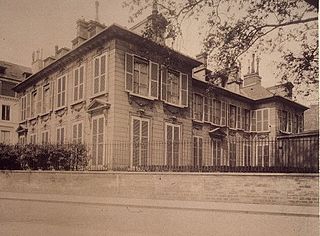
The Hôtel de Massa is an 18th-century hôtel particulier, or large townhouse, at 38 rue du Faubourg Saint-Jacques in the 14th arrondissement of Paris. It was originally located on the avenue des Champs-Élysées and was moved in 1929 to its present location, in a park beside the gardens of the Paris Observatory. Classified as a historical monument, it has since been occupied by the Société des gens de lettres.
Rue de la Bûcherie is a street in the 5th arrondissement of Paris, France.

Le Curé de Tours is a long short story by Honoré de Balzac, written in 1832. Originally entitled Les Célibataires, it was published in that year in volume III of the 2nd edition of Scènes de la vie privée, then republished in 1833 and again in 1839, still with the same title but as one of the Scènes de la vie de province. Not until 1843 did it take on its present title of Le Curé de Tours when it appeared in volume II of Scènes de la vie de province.

The Rue du Bœuf is a 188-metre cobbled pedestrian street of the Vieux Lyon quarter, located in the 5th arrondissement of Lyon. Very representative of the Renaissance architecture of the neighborhood, it is lined only with old houses from the 16th or 17th century. The street connects the rue de Gadagne which it continues after the Place du Petit Collège and the intersection of the rue du Chemin Neuf, the rue de la Bombarde and the rue Tramassac which prolongs it. The street belongs to the zone classified as World Heritage Site by UNESCO.

The Place Croix-Paquet is a square located in the 1st arrondissement of Lyon, in the pentes de la Croix-Rousse quarter. It is formed by the intersection of the rue du Griffon, the rue des Capucins and the montée Saint-Sébastien. The square belongs to the zone classified World Heritage Site by UNESCO.

Massimilla Doni is a short story by Honoré de Balzac.
Sentier is a neighbourhood in the 2nd arrondissement of Paris which has been known historically as a multicultural textile and garment manufacturing district. Since the late 1990s, it has increasingly become home to many Internet start-up companies and has acquired the nickname Silicon Sentier.

A Lorette is a type of 19th-century French prostitute. They stood between the kept women (courtesans) and the grisettes. A grisette had other employment and worked part-time as a prostitute whereas a Lorette supported herself exclusively from prostitution. The lorette shared her favours among several lovers; the Lorette's "Arthurs", as they called them, were not financially able or too fickle to have exclusivity.
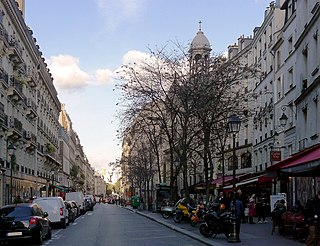
The Rue des Archives is a street in The Marais at the border of 3rd and 4th arrondissements of Paris, France.

Noël Parfait was a French writer, political activist and republican deputy.
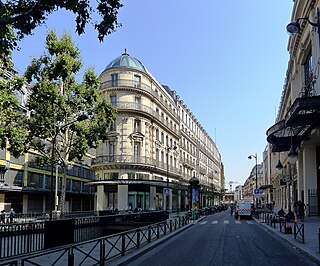
Rue du Pont-Neuf is a street in the 1st arrondissement of Paris, France, shared between Les Halles to the north and Quartier Saint-Germain-l'Auxerrois to the south. It was pierced in the second half of the 19th century.



















